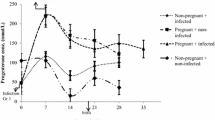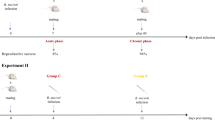Abstract
This study was performed to evaluate sexual transmission of Toxoplasma gondii in mice. RH strain tachyzoites were intraperitoneally inoculated into 10 Balb/C male mice and after 48 h, their semen were collected from epididymis and examined by giemsa staining and PCR. Twenty Balb/C female mice mated with four infected male mice four times and any mating time was 48 h whilst 20 female control mice mated with four uninfected male mice for 8 days. Female mate choice was assessed using a three-chambered cage. Four female mice were placed in a central chamber and in one side of it, two infected male mice were kept and in other side, two naïve male mice were placed. Due each quarter, every of the female movement was reported and then the female was replaced to middle chamber. Besides on the detection of DNA and whole parasite in semen, no abortion and death was seen in female mice. Pregnancy was seen only 4 out of 20 female mice which mated with infected males while 17 pregnancies were seen from 20 control female mice (P value = 0.0001). No statistical significant was seen in female mate choice between naïve male (45 movement) and infected male (36 movement). This study showed that toxoplasmosis could not transmit to female mice and their offspring due to mating and the parasite had not effect on female mate choice. It seems that infected male mice cannot entirely mate with females due to reduction of male weapon and body size, physiological vigor and energy.

Similar content being viewed by others
References
Agrawal AF (2006) Similarity selection and the evolution of sex: revisiting the red queen. PLoS Biol 4:1364–1371
Akins CK, Panicker S, Cunningham CL (2004) Laboratory animals in research and teaching: ethics, care, and methods. APA, Washington, DC
Arantes TP, Lopes WDZ, Ferreira RM, Pieroni JSP, Pinto VMR, Sakamoto CA, Costa AJD (2009) Toxoplasma gondii: evidence for the transmission by semen in dogs. Exp Parasitol 123:190–194
Asgari Q, Farzaneh A, Kalantari M, Mohajeri FA, Moazeni M et al (2006) Seroprevalence of free-ranging chicken toxoplasmosis in sub-urban regions of Shiraz. Iran Int J Poult Sci 5:262–264
Asgari Q, Moazzeni M, Akrami FM, Kalantri M, Zarifi M et al (2007) Seroprevalence of Toxoplasma gondii among caprines in Fars Province, Southern Iran. J Vet Parasitol 21:153–155
Asgari Q, Mehrabani D, Moazzeni M, Akrami-Mohajeri F, Kalantari M, Motazedian MH, Hatam GR (2009) The seroprevalence of ovine toxoplasmosis in Fars Province, Southern Iran. Asian J Anim Vet Adv 4:332–336
Asgari Q, Mehrabani D, Moazeni M, Akrami-Mohajeri F, Kalantari M et al (2010) The seroprevalence of bovine toxoplasmosis in Fars Province, Southern Iran. Asian J Anim Vet Adv 5:210–216
Asgari Q, Mehrabani D, Motazedian MH, Kalantari M, Nouroozi J, Adnani Sadati SJ (2011) The viability and infectivity of Toxoplasma gondii tachyzoites in dairy products undergoing food processing. Asian J Anim Sci 5:202–207
Buchholz R (2003) Effects of parasitic infection on mate sampling by female wild turkeys (Meleagris gallopavo): should infected females be more or less choosy? Behav Ecol 15(4):687–694
Dass SA, Vasudevan A, Dutta D, Soh LJ, Sapolsky RM, Vyas A (2011) Protozoan parasite Toxoplasma gondii manipulates mate choice in rats by enhancing attractiveness of males. PLoS ONE 6:e27229
Dubey JP (2002) Tachyzoite-induced life cycle of Toxoplasma gondii in cats. J Parasitol 88(4):713–717
Dubey JP, Jones JL (2008) Toxoplasma gondii infection in humans and animals in the United States. Int J Parasitol 38:1257–1278
Ehman KD, Scott ME (2002) Female mice mate preferentially with non-parasitized males. Parasitology 125:461–466
Flegr J (2000) Effects of Toxoplasma on human behavior. Schizophr Bull 33:757–760
Gandon S, Otto SP (2007) The evolution of sex and recombination in response to abiotic or coevolutionary fluctuations in epistasis. Genetics 175:1835–1853
Hamilton WD, Zuk M (1982) Heritable true fitness and bright birds—a role for parasites. Science 218:384–387
Hedrick PW (2002) Pathogen resistance and genetic variation at MHC loci. Evolution 56:1902–1908
Hodkova H, Kodym P, Flegr J (2007) Poorer results of mice with latent toxoplasmosis in learning tests: impaired learning processes or then novelty discrimination mechanism? Parasitology 134:1329–1337
Howard RS, Lively CM (2004) Good vs complementary genes for parasite resistance and the evolution of mate choice. BMC Evol Biol 4:48
Jones CD, Okhravi N, Adamson P, Tasker Sh, Lightman S (2000) Comparison of PCR detection methods for B1, P30, and 18S rDNA genes of T. gondii in aqueous humor. IOVS 41(3):634–644
Kankov Š, Kodym P, Flegr J (2011) Direct evidence of Toxoplasma-induced changes in serum testosterone in mice. Exp Parasitol 128:181–183
Lopes WD, Costa AJ, Souza FA, Rodrigues JD, Costa GH, Soares VE, Silva GS (2009) Semen variables of sheep (Ovis aries) experimentally infected with Toxoplasma gondii. Anim Rep Sci 111(2–4):312–319
Milinski M (2006) The major histocompatibility complex, sexual selection, and mate choice. Annu Rev Ecol Evol Syst 37:159–186
Milinski M, Hmilton B (2001) Sexual and parasite. Behav Ecol 12:264–266
Møller AP, Christe P, Lux E (1999) Parasitism, host immune function, and sexual selection. Q Rev Biol 74:3–20
Montoya JG, Liesenfeld O (2004) Toxoplasmosis. Lancet 363:1965–1976
Moraes EPBX, Freitas AC, Gomes-Filho MA, Guerra MMP, Silva MAR, Pereira MF, Braga VA, Mota RA (2010) Characterization of reproductive disorders in ewes given an intrauterine dose of Toxoplasma gondii tachyzoites during the intrauterine insemination. Anim Rep Sci 122:36–41
Mougeot F, Redpath SM, Piertney SB (2005) Elevated spring testosterone increases parasite intensity in male red grouse. Behav Ecol 17(1):117–125
Oksenhendler E, Charreau I, Tournerie C, Azihary M, Carbon C, Aboulker JP (1994) Toxoplasma gondii infection in advanced HIV infection. AIDS 8(4):483–487
Pereira KS, Franco RM, Leal DA (2010) Transmission of toxoplasmosis (Toxoplasma gondii) by foods. Adv Food Nutr Res 60:1–19
Polak M, Luong LT, Starmer WT (2007) Parasites physically block host copulation: a potent mechanism of parasite-mediated sexual selection. Behav Ecol 18(5):952–957
Smith JE, Reduck NR (2000) Toxoplasma gondii strain variation and pathogenicity. In: Cary JW, Linz JE, Bhatnaga B (eds) Microbial foodborne diseases: mechanisms of pathogenesis and toxin synthesis. Technnomic, Lancaster
Spence JB, Beattie CP, Faulkner J, Henry L, Watson WA (1978) Toxoplasma gondii in the semen of rams. Vet Rec 102(2):38–39
Teale AJ, Blewett DA, Miller JK (1982) Experimentally induced toxoplasmosis in young rams: the clinical syndrome and semen secretion of Toxoplasma. Vet Rec 111(3):53–55
Terpsidis KI, Papazahariadou MG, Taitzoglou IA, Papaioannou NG, Georgiadis MP, Theodoridis I (2009) Toxoplasma gondii: reproductive parameters in experimentally infected male rats. Exp Parasitol 121:238–241
Torrey EF, Yolken RH (2003) Toxoplasma gondii and schizophrenia. Emerg Infec Dis 9:1375–1380
Vyas A (2013) Parasite-augmented mate choice and reduction in innate fear in rats infected by Toxoplasma gondii. J Exper Biol 216:120–126
Webster JP (2007) The effect of Toxoplasma gondii on animal behavior: playing cat and mouse. Schizophr Bull 33(3):752–756
Acknowledgments
The authors would like to thank the Office of Vice-Chancellor for Research of Tehran University of Medical Sciences and Tehran University for financial support of this project. We also thank the staff of the Animal Laboratory Centre, Shiraz University of Medical Sciences for cooperation in experimental studies.
Author information
Authors and Affiliations
Rights and permissions
About this article
Cite this article
Asgari, Q., Keshavarz Valian, H., Rezaeian, M. et al. Toxoplasma gondii: sexual transmission in mice. J Parasit Dis 39, 253–257 (2015). https://doi.org/10.1007/s12639-013-0330-5
Received:
Accepted:
Published:
Issue Date:
DOI: https://doi.org/10.1007/s12639-013-0330-5




